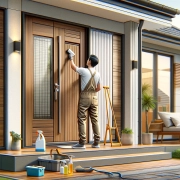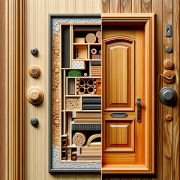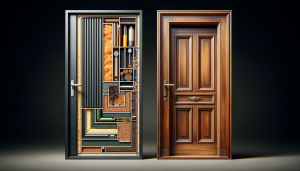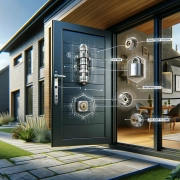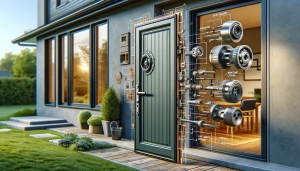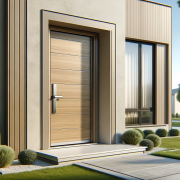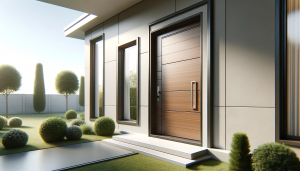Composite Door Maintenance
Composite Door Care: The Ultimate Guide to Maintaining Your Door’s Beauty and Functionality
Composite doors have surged in popularity thanks to their durability, security, and aesthetic appeal. Unlike traditional wooden doors, they require a different approach to maintenance to ensure they remain as functional and attractive as the day they were installed. In this practical guide, we’ll delve into the essential maintenance tips to keep your composite door in top condition, from basic cleaning to aesthetic upkeep.
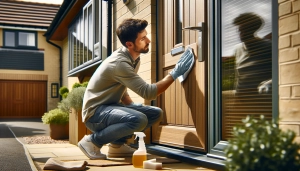
Basic Maintenance Tips for Composite Doors
Cleaning Procedures and Products
To maintain the pristine condition of your composite door, regular cleaning is paramount. Start with a soft cloth and a mild soapy solution to wipe down the surface. Avoid abrasive cleaners or scouring pads, as these can damage the door’s finish. For glass panels, use a quality glass cleaner for a streak-free shine.
Periodic Inspection Checklist
Every few months, take the time to inspect your door thoroughly. Check for any signs of damage, such as scratches or dents, and ensure that the seals are intact to prevent drafts. Pay special attention to the moving parts, such as hinges and locks, which we’ll discuss in more detail shortly.
Addressing Common Wear and Tear
Even with the most robust materials, wear and tear are inevitable. Should you find any minor scratches, often a touch-up pen designed for composite doors can camouflage the damage. For more significant issues, consult with a professional to assess whether a repair or replacement is necessary.
Seasonal Care for Composite Doors
Preparing for Winter: Insulation and Sealant Checks
As winter approaches, it’s crucial to ensure your door’s insulation and sealants are in good condition. Check the weather stripping around the door to prevent heat loss and keep your home cosy. Adjust or replace any worn-out seals to maintain energy efficiency.
Summer Upkeep: UV Protection and Heat Resistance
Composite doors are typically resistant to the harsh effects of UV rays and heat, but it’s still wise to take precautions. If your door is exposed to direct sunlight, consider using a UV protective spray to prevent fading. Additionally, ensure that any moving parts are not overly tightened, as heat can cause materials to expand.
Transitioning Through Spring and Fall: Managing Moisture and Debris
During the wetter months of spring and autumn, keeping your door clean from debris and moisture is essential. Clear any leaves or detritus from the door’s threshold and use a dry cloth to wipe away any excess moisture that could seep into seals or joints.
Hardware Maintenance for Longevity
Hinges and Locks: Lubrication and Adjustment
Hinges and locks are the workhorses of your door’s functionality and require regular lubrication to operate smoothly. Use a silicone-based lubricant every six months to keep these components moving freely. If you notice any stiffness or squeaking, it may be time for an adjustment or additional lubrication.
Door Handles and Letterboxes: Cleaning and Polishing
Door handles and letterboxes should be cleaned with the same mild soapy solution used for the door itself. To maintain their lustre, you can apply a car wax or specialist metal polish, ensuring that these elements remain corrosion-free and gleaming.
Threshold and Frame Care: Ensuring Stability and Fit
Inspect the threshold and door frame regularly for any signs of damage or warping. Keeping these areas clean and free from debris will prevent issues with the door closing and ensure a snug fit, which is critical for insulation and security.
Aesthetic Upkeep of Composite Doors
Colour Fading: Prevention and Treatment
Although composite doors are designed to be fade-resistant, prolonged exposure to sunlight can lead to some discolouration over time. You can prevent this by applying a specialist top coat designed for composite materials, which will also enhance the door’s weather resistance.
Scratch and Dent Repair Techniques
For minor scratches, use a repair kit specifically designed for composite doors. For deeper scratches or dents, it may be possible to fill and repaint the affected area, but this should ideally be done by a professional to ensure a perfect match with the existing finish.
Refreshing Door Appearance: When to Repaint or Refinish
If your door starts to look tired or you simply fancy a change, repainting or refinishing can give it a new lease of life. It’s important to use products that are compatible with the composite material and to follow the manufacturer’s instructions carefully to achieve the best results.
Preventative Measures for Composite Door Care
Avoiding Damaging Practices and Products
To preserve the integrity of your composite door, it’s crucial to avoid using harsh chemicals, high-pressure washers, or abrasive tools for cleaning. Stick to recommended cleaning agents and methods. Additionally, ensure that the door is not subjected to unnecessary force or impact, which could compromise its structure.
Installing Protective Features: Rain Drips and Canopies
Implementing protective features such as rain drips and canopies can greatly extend the life of your door. These additions help to shield the door from the elements, preventing water ingress and sun damage, and subsequently reducing the need for frequent maintenance.
Educating Household Members and Visitors on Proper Usage
Simple habits can make a significant difference in the longevity of your door. Educate your household and guests on the importance of gentle usage, like avoiding slamming the door or hanging heavy items on the door handle, which could lead to misalignment or damage.
Troubleshooting Common Composite Door Issues
Sticking or Misaligned Doors: Adjustments and Fixes
A common issue with composite doors is sticking or misalignment, often due to temperature fluctuations. This can usually be resolved by adjusting the hinges to realign the door within its frame. Regular checks will prevent minor issues from becoming major inconveniences.
Drafts and Leaks: Detecting and Sealing Gaps
If you notice drafts or leaks, it’s time to inspect the seals and weather stripping. Replacing worn seals is a relatively simple and cost-effective way to solve this problem, ensuring your home remains energy-efficient and comfortable.
Long-term Care and Replacement Considerations
Life Expectancy of Composite Doors
Composite doors are built to last, often having a life expectancy of 30 years or more. However, this longevity is contingent on regular maintenance and timely repairs. By adhering to the care guidelines provided, you can ensure your door serves you well into the future.
Signs That Indicate Replacement Is Needed
Be vigilant for signs that may indicate your door requires replacement, such as persistent drafts, difficulty in operation, or visible warping. These symptoms suggest that the door may no longer be performing effectively and could compromise your home’s security and insulation. To conclude, composite doors offer a fantastic balance of style, security, and durability. Yet, like any important investment, they require regular maintenance to keep them functioning at their best. By following this two-part guide, you can ensure that your composite door remains as robust and inviting as the day you installed it—truly a doorway to the comfort and safety of your home.

